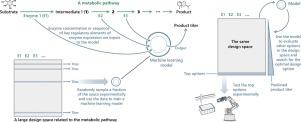Current Opinion in Biotechnology ( IF 7.7 ) Pub Date : 2020-09-04 , DOI: 10.1016/j.copbio.2020.08.004 Kang Zhou 1 , Wenfa Ng 1 , Yoel Cortés-Peña 2 , Xiaonan Wang 1

|
Machine learning is transforming many industries through self-improving models that are fueled by big data and high computing power. The field of metabolic engineering, which uses cellular biochemical network to manufacture useful small molecules, has also witnessed the first wave of machine learning applications in the past five years, covering reaction route design, enzyme selection, pathway engineering and process optimization. This review focuses on pathway engineering, and uses a few recent studies to illustrate (1) how machine learning models can be useful in overcoming an evident rate-limiting step, and (2) how the models may be used to exhaustively search – or guide optimization algorithms to search – a large design space when the cellular regulation of the reaction network is more convoluted.
中文翻译:

通过使用机器学习模型来增加代谢途径通量。
机器学习通过自我完善的模型正在改变许多行业,而自我完善的模型则由大数据和高计算能力推动。使用细胞生化网络制造有用的小分子的代谢工程领域在过去五年中也见证了机器学习应用的第一波浪潮,涉及反应路线设计,酶选择,途径工程和工艺优化。这篇综述着重于路径工程,并使用了一些最新研究来说明(1)机器学习模型如何在克服明显的速率限制步骤方面有用,以及(2)如何将这些模型用于详尽搜索或指导搜索的优化算法–当反应网络的细胞调控更加复杂时,这是一个很大的设计空间。



























 京公网安备 11010802027423号
京公网安备 11010802027423号